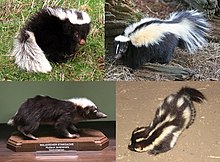Our website is made possible by displaying online advertisements to our visitors.
Please consider supporting us by disabling your ad blocker.
Mephitidae
| Mephitidae Temporal range:
| |
|---|---|

| |
| Molina's hog-nosed skunk (Conepatus chinga), striped skunk (Mephitis mephitis), Sunda stink badger (Mydaus javanensis) and western spotted skunk (Spilogale gracilis) | |
| Scientific classification | |
| Domain: | Eukaryota |
| Kingdom: | Animalia |
| Phylum: | Chordata |
| Class: | Mammalia |
| Order: | Carnivora |
| Superfamily: | Musteloidea |
| Family: | Mephitidae Bonaparte, 1845 |
| Type genus | |
| Mephitis | |
| Genera | |
|
Conepatus | |

| |
| Mephitidae range | |
Mephitidae is a family of mammals comprising the skunks and stink badgers. They are noted for the great development of their anal scent glands, which they use to deter predators. Skunks were formerly classified as a subfamily of the Mustelidae (the weasel family); however, in the 1990s, genetic evidence caused skunks to be treated as a separate family.[1] Similarly, the stink badgers had been classified with badgers, but genetic evidence shows they share a more recent common ancestor with skunks, so they are now included in the skunk family. A 2017 study using retroposon markers indicated that they are most closely related to the Ailuridae (red pandas and allies) and Procyonidae (raccoons and allies)[citation needed].
There are twelve extant species of mephitids in four genera: Conepatus (hog-nosed skunks, four species); Mephitis (the hooded and striped skunks, two species); Mydaus (stink badgers, two species); and Spilogale (spotted skunks, four species). The two stink badgers in the genus Mydaus inhabit Indonesia, Brunei, Malaysia and the Philippines; the other members of the family inhabit the Americas, ranging from Canada to central South America. All other mephitids are extinct, known through fossils, including those from Eurasia.[2][3][4]
In taxonomic order, the living species of Mephitidae are:[5]
- ^ "Wild Skunk Information". Dragoo Institute for the Betterment of Skunks and Skunk Reputations. 7 March 2013. Retrieved 12 November 2017.
- ^ Xiaoming Wang; Zhanxiang Qiu (2004). "Late Miocene Promephitis (Carnivora, Mephitidae) from China". Journal of Vertebrate Paleontology. 24 (3): 721–731. doi:10.1671/0272-4634(2004)024[0721:LMPCMF]2.0.CO;2. S2CID 21714530.
- ^ Koepfli KP, Deere KA, Slater GJ, et al. (2008). "Multigene phylogeny of the Mustelidae: Resolving relationships, tempo and biogeographic history of a mammalian adaptive radiation". BMC Biol. 6: 4–5. doi:10.1186/1741-7007-6-10. PMC 2276185. PMID 18275614.
- ^ Mammal Species of the World – Browse: Mephitidae . Bucknell.edu. Retrieved on April 5, 2012.
- ^ Wilson, D. E.; Reeder, D. M., eds. (2005). Mammal Species of the World: A Taxonomic and Geographic Reference (3rd ed.). Johns Hopkins University Press. ISBN 978-0-8018-8221-0. OCLC 62265494.
Previous Page Next Page


